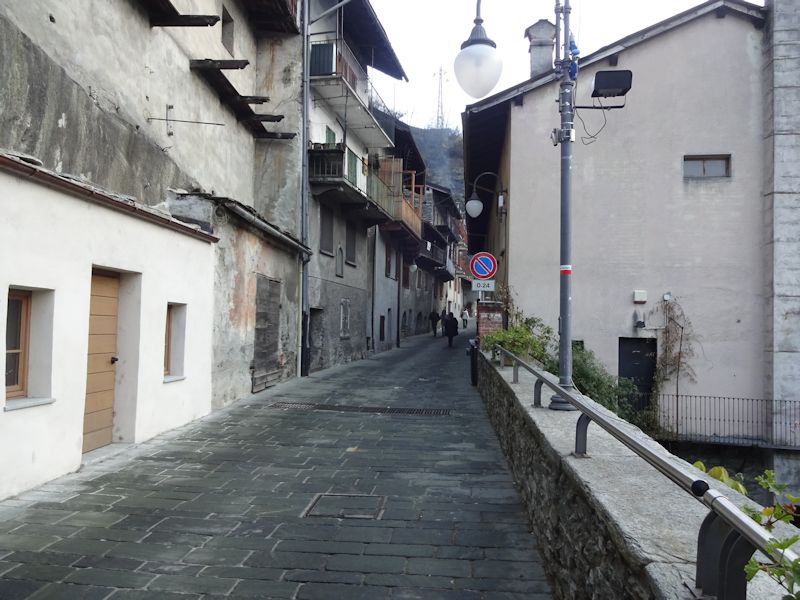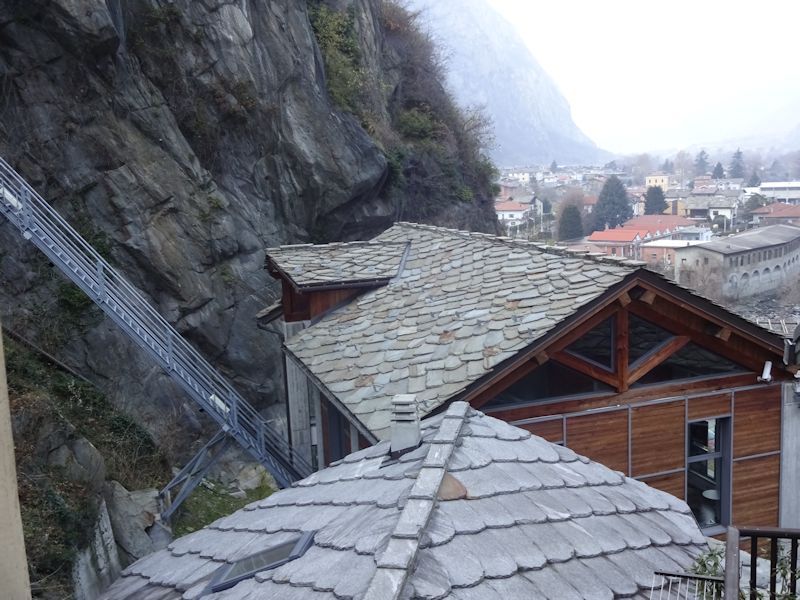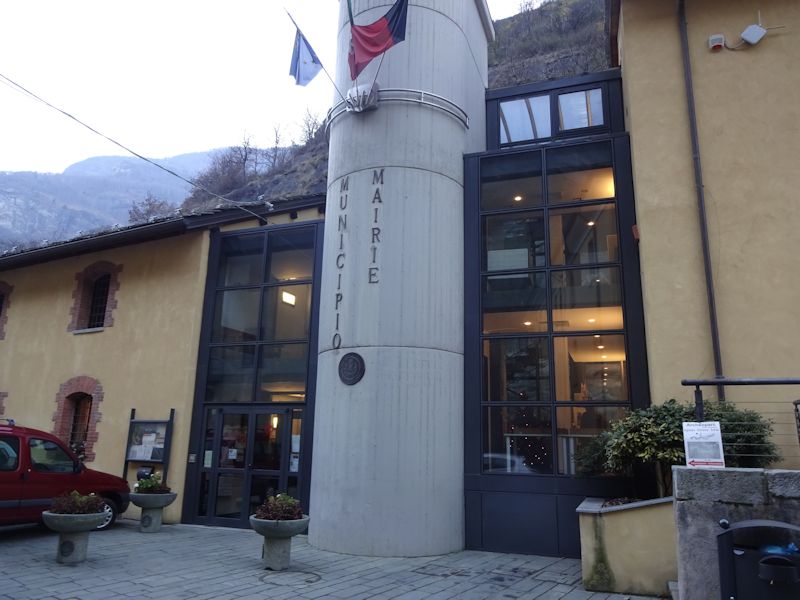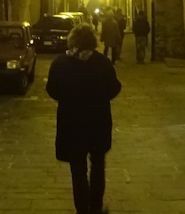You may not find this terribly rewarding unless you're included here, so this is a good time for casual and random browsers to turn back before they get too caught up in the sweep and majesty of the proceedings and can't let go.
We've got an annual pass for the Grand St-Bernard tunnel, and it expires at Christmas.

It's 20 December 2015, and we've come to investigate Fort Bard, leaving time to get home by Christmas Eve, when most years we can't find any restaurants open anywhere and have to dine on bar snacks.

This is Bard village -- a medieval single street tucked in between the valley walls and the huge rock knob atop which sits the fortress. Kristin's raced ahead to find our B+B, the Casa Ciuca, which Google Maps had unhelpfully placed down on the state route by the river.

Our room in the Casa Ciuca is actually a spacious but inexpensive apartment, spartan in its furnishings and amenities, but otherwise very comfortable. This is the diningroom with kitchen.

Bard is a hopefully thriving village of 130 citizens, located directly about 80m below the Forte di Bard (in Italian; Fort de Bard in French, equally important in this region; and Fort Bard in English as a convenient compromise)

The only annoying thing about our four days in Bard, an economically understandable one perhaps, is that posters everywhere celebrate the village as the location for a film called Marvel Avengers, Age of Ultron, in March 2014, which by the look of the posters must have been a nightmare.

A little guest room, as it were, between the kitchen and the bedroom

The view out the window -- we're poised conveniently directly over the funicular lift to the top of the fortress.

Traditionally, Squirrel, when discomfited by new surroundings, hides in the closets for a day or two, so she's probably waiting for us to close these doors and pretend that no one knows she's there. (In Gubbio, she doubled down and hid in the safe, which was in the closet.)

The Casa Ciuca (the 'drunken house') is basically an important 16th century house which now sports the renovated apartments upstairs and a chic wine bar that in summer spills out into various related spaces in the little complex.

The view out the back

We're reconnoitering the village -- this is the high street, Via Vittorio Emanuele II of course, and there are no others.

The Challant house, from the late 15th century. The Challants, viscounts of Aosta, were one of the most powerful families of the Val d'Aosta in medieval times, and many of the castles surviving in the valley were at one time theirs. This house is thought to have been built by Philiberto, Lord of Bard Castle (a predecessor of the vast hulks up there now), between 1487 and 1517.

Bard street scenes


The central piazza

The fortress above

The mairie, or municipio, in a rather different style than other buildings in town. Note the required bilingualism here. An exhibition of Christmas crèches or manger scenes (or as they also say here, presepe) is going on inside.

There was a church here, belonging to the Bishop of Aosta, since at least 1176, but the present building was consecrated in 1868.

The bell tower, however, dates from the late 13th century.

Fort Bard, built in the 1830s (more about that later), was rescued from desuetude, thoroughly cleaned up, and reopened in 2006 as a Big Something. It's got a permanent Museum of the Alps, a Children's Alps Museum, a Fortress Museum and a Frontier Museum, a visitable prison (so they say), a restaurant, and some independent artisanal shops, as well as exhibition spaces for some fairly prestigious shows.

We're rising above Bard.

The nets minimize the damage from rockfall.

This is near the top of the first lift, the bottom of the second one. Right now, in late afternoon, we're on our way to the exhibition halls at the tippy-top of the fortress to see the exhibition "Golden Age: Jordaens, Rubens, Brueghel", the Hohenbuchau Collection from Liechtenstein, "114 paintings which are representative of the Dutch and Flemish Golden Age". ("Representative" might not be the highest bar to be got over.)

-- Push the button. Up we go. (Push it again. Clank! Okay, up we go.)

We get to float up in upholstered comfort, 'cause we're paying customers. This is the way the soldiers got up and down through here -- covered passages fairly safe in wartime if you duck your head under the windows, but surely tiresome after a while.

Bard below -- it looks like we're about 70m or 80m above the village here near the top.

The central courtyard of the top fortress, lit up for Christmas

The gate out to the south, the back of the fortress as it were. We'll have a go at this in a few days.

The corridor leading to the Golden Age exhibit, for a fairly nominal fee

Unfortunately, the exhibition was a No Photo! zone, heavily patrolled, so that's all one could get away with this time (and it was a near thing). Kristin was very favorably impressed with the works displayed; I thought that much of it was uninspiring (I'll never learn to appreciate plates of fruit and flowers and dead game birds), and the one Brueghel didn't even make me laugh, which doesn't happen often.

Night falls as we regain terra firma. That's the 13th century bell tower, fancified for modern tastes.

There are few things so beautiful as a medieval street at night with modern streetlamps on.

Kristin's planning dinner, as always (planning begins at about noon). We'll be tramping across the medieval bridge to the village of Hône next door to try the Albergo del Mulino. We loved it, though our first night required a long wait whilst a troupe of ill-behaved brats and their negligent parents worked their noisy way through a birthday party; we patronized the establishment three of our four nights in town, the family staff were very sympa.

Fort Bard has its own story, a fascinating one (including Napoleon), and we'll come back to that in a few days -- first, we need to take a couple of day trips.

I would have been useless in medieval times -- I could never have got through that door. (There are other reasons, too, but never mind.)
The road to Ivrea

We're outside the Casa Ciuca in Bard the next morning, watching the traffic proceed up the hill and preparing for our journey into Ivrea. Ivrea is an industrial city at the foot of the Val d'Aosta as you find yourself out on the Po Valley plains of the Piemonte between Milan and Turin; we visited a very old B+B castle near there a generation ago, with all the children, but have never seen the city itself, and always wondered.

That's the number one funiculaire, of three. We'll come back.

Non-residents don't park in Bard (and few residents either, probably), but there's free parking for tourists a few hundred meters up the SS26 state route and fairly inexpensive pay-parking at the bottom of the funiculaire. We're happy to walk a few hundred meters to avoid even the least expensive of the paid parking.

This view shows all three funiculaire tracks, though the highest one is hard to make out. And after that, there's a conventional elevator to the top floor.

-- Wait up! (Kristin doesn't suffer tourist photographers gladly.)

The Dora Baltea river, which created this long valley and, here near Bard, this gorge. Actually, the river and the glaciers.

The medieval foot bridge from Bard to Hône (our nightly processional)

The Dora Baltea river, looking northward, and the elegant walkway thoughtfully provided to cut down on the tourist fatalities along the SS26 truck route.

Southward to Ivrea, past a castle that may warrant further investigation later.
 Dwight Peck's personal website
Dwight Peck's personal website
















































